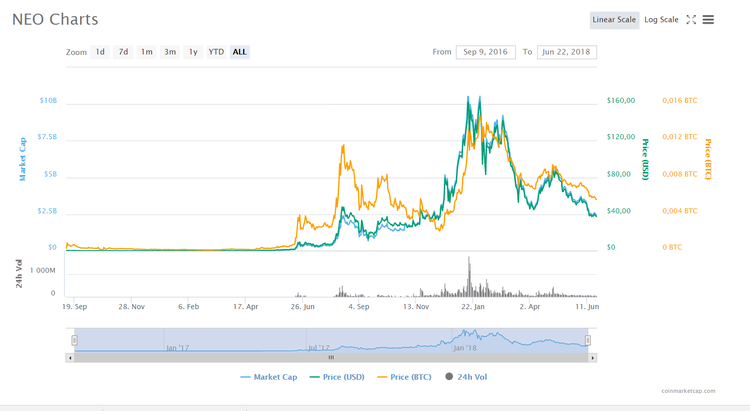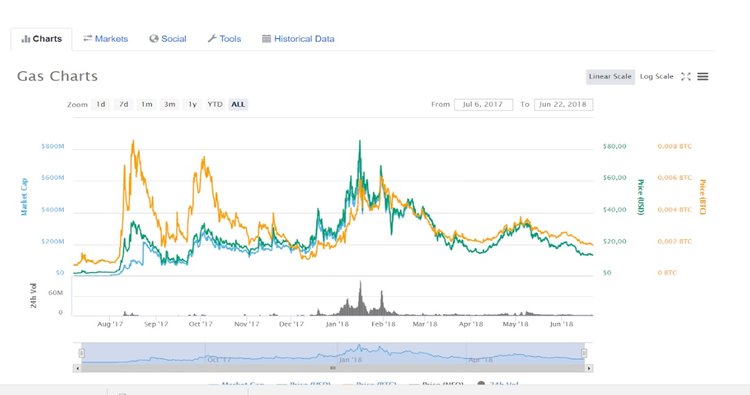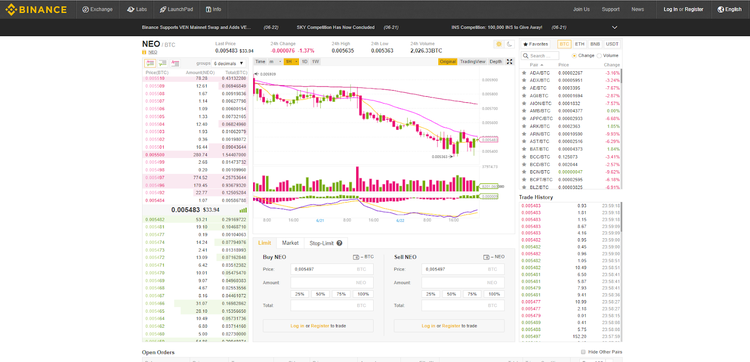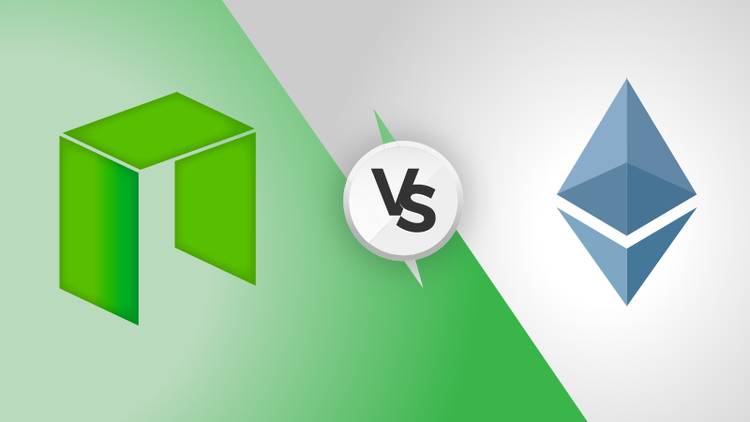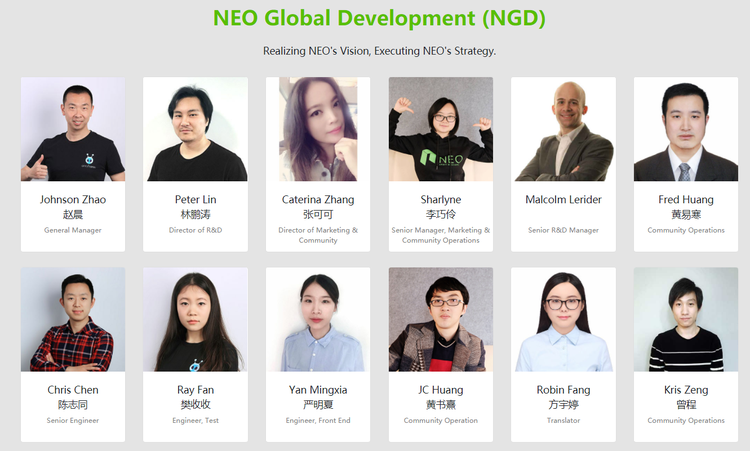Distributed Platform for “Smart Economy”
NEO is a blockchain platform and cryptocurrency designed to build a scalable network of decentralized applications. NEO is a distributed network that combines digital assets, digital identities and smart contracts.
NEO utilizes the blockchain technology and digital identity to digitize assets, to automate the management of digital assets using smart contracts, and to realize a "smart economy" within a distributed network.
NEO was originally launched in 2014 as AntShares and was rebranded to NEO in June 2017.
According to the post on the platform’s website, NEO was created to push our traditional economy into an era of Smart Economy.
NEO Smart Contract
Dubbed China’s ethereum for offering smart contracts, NEO has an independent smart contract system: NeoContract.
With NeoContract system, developers do not need to learn a new programming language but use C#, Java and other mainstream programming languages in their familiar IDE environments (Visual Studio, Eclipse, etc.) for smart contract development, debugging and compilation.
The NeoContract will allow millions of developers around the world to quickly carry out the development of smart contracts.
NEO Tokens
NEO has two native tokens, NEO (abbreviated symbol NEO) and NeoGas (abbreviated symbol GAS).
GAS is the fuel token for the realization of NEO network resource control, with a maximum total limit of 100 million. The NEO network charges for the operation and storage of tokens and smart contracts, thereby creating economic incentives for bookkeepers and preventing the abuse of resources. The minimum unit of GAS is 0.00000001.
The price per NEO began at less than $0.60 cents, and stands at around the $37 mark. Price tracker CoinMarketCap.com ranks NEO as the 12th largest cryptocurrency with a total market cap of over $2.4 billion and a daily trading volume of $67 million.
GAS tokens are used to power smart contracts, and the fees are paid to NEO holders. GAS is the token to pay for all the service fees on the blockchain. Any company that desires to register or change assets on the blockchain will have to acquire GAS.
NEO holders gain their extra GAS from registration and changing of assets, not from transaction fees. More users joining the blockchain will lead to more assets being registered, resulting in more GAS being distributed to NEO holders. This is distributed proportionally, so it doesn’t matter if one is holding 1 NEO or 1000 NEO in terms of percentage gain.
GAS is currently listed 78th on CoinMarketCap.com. At a price of around $13, it has a total market capitalization of almost $133 million and a daily trading volume of $3.6 million.
While many tokens are built on a “Proof-of-Work” or “Proof-of-Stake” foundation, the NEO token uses the Delegated Byzantine Fault Tolerance consensus algorithm. The mechanism ensures more efficient scalability and better protection against bad actors.
There are no transaction fees on NEO network. The lack of fees supports network growth, benefitting all NEO holders. However, the could be introduced in the future.
NEO/GAS Distribution
A total of 100 million NEO were created in the Genesis Block. Fifty million tokens were sold to early investors, with the remaining 50 million of NEO locked into a smart contract.
Each year, 15 million NEO tokens are unlocked, and the development team can use the funds to boost long-term development goals.
GAS started off from scratch — with the initial amount of zero. However, its being generated with each new block. It would take approximately 22 years to generate 100 GAS. 12 months are required to generate 2 million blocks with intervals between each pair of blocks of about 15-20 seconds.
At the beginning, generating GAS will come at a pace of 8 per block until about 2 million blocks are produced. Then the annual generation will be reduced by a one GAS per block per year. The rate will eventually decrease to just one GAS per block. The total GAS generation is expected to stop after 44 million blocks are created and the top level of 100 million reached.
The first year will see 16% of the GAS created while 52% of the GAS is expected to be generated in the first four years. Tokens will be distributed proportionally among the NEO community.
To receive GAS its necessary to hold NEO in a wallet. Those holding the tokens on an exchange will not receive any.
NEO Wallets
There are Mobile, Desktop and Web based wallets available. The NEO Team and community have created various wallets for different platforms, which can be download on the official website.
Those who prefer hardware wallets can chose between Ledger Blue and Ledger Nano S.
NEO: How to buy
NEO can be bought from a number of major petrocurrency exchanges including Binance, Bitfintex, OKEx, Huobi, Upbit, HitBTC, Bittrex and other. The easiest way to buy NEO is through bitcoin and ethereum.
Hitbtc is currently the only exchange that accepts fiat money (USD, EUR, GBP, etc.) and enables NEO purchasing.
NEO vs. Ethereum
NEO and ethereum are both blockchain projects specifically designed to host smart contracts, ICOs, and DApps in a decentralized manner. While the two share much in common, they differ in a number of ways.
The speed of transactions is one of the major differences. NEO processes transactions faster than ethereum. NEO can transact at 1,000tps achieving a maximum speed of 10,000tps, while ethereum transacts at 15tps with a 30tps maximum.
Ethereum uses the Proof of Work (PoW) protocol, while NEO uses the Delegated Byzantine Fault Tolerance (Dbft), which may enable NEO to scale more efficiently than other consensus proofs and protect better against bad actors.
NEO supports programming in multiple languages like C++, C#, Go, Java, thus enabling anyone with a knowledge of one of these languages to start building projects on its blockchain. Ethereum, on the other hand, allows coding only in one language — Solidity. As it is a new language, anyone who wants to build DApps or smart contracts needs to learn it first.
The native crypto-fuel of NEO’s blockchain is not divisible. It only exists in whole numbers (1,2,50,1000, etc.), while the native crypto-fuel of ethereum is divisible and can be divided (3.4352, 283.399403, etc.).
NEO is focused on making a smart economy by digitizing traditional real world assets via digital identity, along with running smart contracts and DApps. Ethereum aims to become the world’s only supercomputer based on the blockchain.
Ethereum forks to upgrade its software. NEO, on the other hand, has finality and cannot fork.
NEO Team
The NEO development resources were provided by founder Da Hongfei through his development company Onchai, which engaged in design, research and development of the blockchain distributed ledger system that aims to be the Microsoft or Apple of the blockchain.
The NEO team is led by Da Hongfei, founder and core developer Zhang Zhengwen, secretary general Tao Rongqi, as well as other community developers, operators, and contributors.
NEO Partnerships
Alibaba and Microsoft are two companies that support NEO.
Chinese e-commerce giant Alibaba allows clients to use NEO coins to shop and offers a wide range of goods for purchase.
According to Global Coin Report, Microsoft is using NEO to ensure fast and secure access to its products using NEO as payment.
NEO Initiates Open Blockchain Foundation
On Jun 22 NEO announced that it initiated the Open Blockchain Foundation (OBF) and donated the unclaimed $1.8 million from NEO giveback plan as the first contribution to the fund. OBF is an independent neutral foundation with a mission to support the R&D of the blockchain technology in general.
By Bob Loxley



